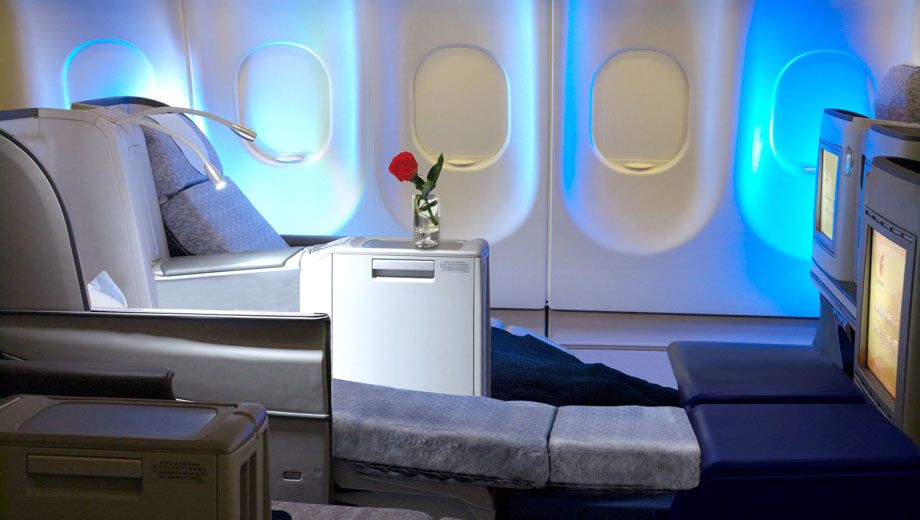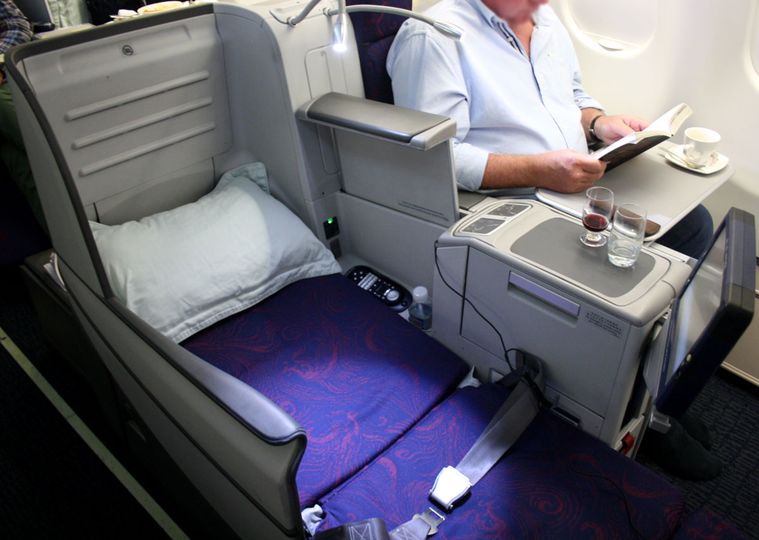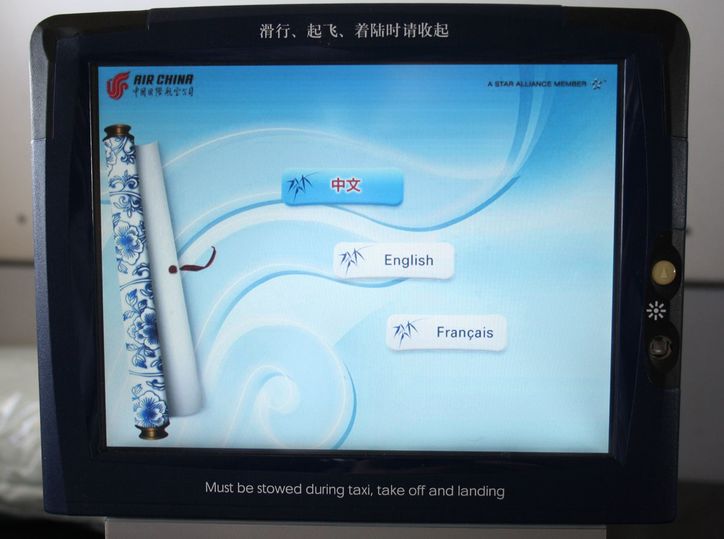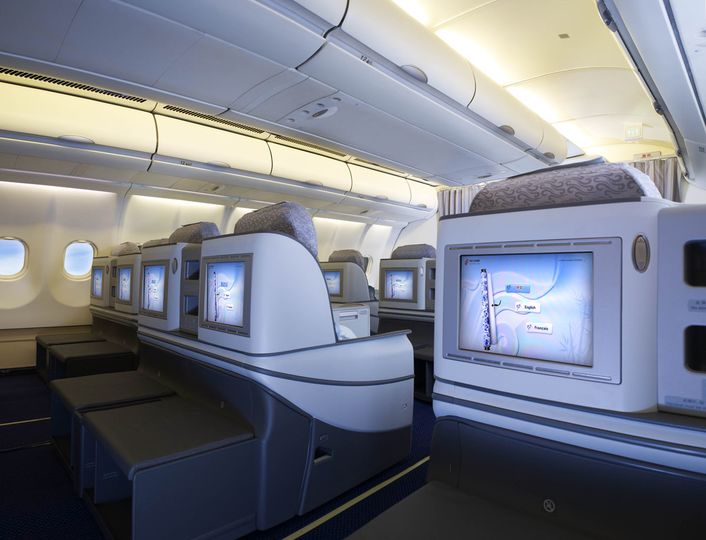Review: Air China A330 business class: Melbourne-Shanghai-Beijing

Route
Melbourne - Beijing (via Shanghai)
Aircraft Type
Airbus A330-200
Airline
Air China
Flight
CA178
Cabin Class
Business
Seat
11C
Notes
The Good
- Fully-flat, 190cm beds
- English-speaking crew offer proactive but unobtrusive service
- Earn Virgin Australia Velocity points via Singapore Airlines KrisFlyer
The Bad
- Clunky entertainment system with relatively limited movie, TV choices
- Forced darkness on a daytime flight
X-Factor
- Impressive multicultural menus with 'dine on demand'
Introduction
With a mostly-French wine list and extensive inflight dining menus that suit both Western and Asian palates, Air China has upped its game in recent years and replaced those older 'sloping sleepers' with fully-flat beds that business class travellers have come to expect on longer flights.
You'll also find these newer flatbeds on the airline's Sydney-Shanghai and Sydney-Beijing services, and from June 1, also non-stop from Melbourne to Beijing in addition to Melbourne-Shanghai: here's how we found them on our 14-hour trek to China.
Check-in
- Frequent flyer program: Air China PhoenixMiles. You can also earn points in other Star Alliance schemes such as Thai Royal Orchid Plus, United MileagePlus and Singapore Airlines KrisFlyer, where KrisFlyer miles can be converted into Virgin Australia Velocity points.
- Chauffeured transfers: Complimentary for business class passengers in selected Chinese cities including Beijing and Shanghai when reserved at least 48 hours before departure, but excluding tickets booked using frequent flyer points or through other airlines, or chauffeur transfers to/from Australian airports.
- Priority check-in and boarding: Yes, dedicated lanes for business class and Star Alliance Gold frequent flyers.
- Checked baggage allowance: 2x32kg bags, plus a third 32kg bag for Star Alliance Gold members and PhoenixMiles Silver, Gold and Platinum frequent flyers.
- Carry-on baggage allowance: 2x115cm bags at a combined total weight of up to 8kg.
- Priority security screening, passport control (Australia departures): Yes, via Express Path.
- Priority passport control, Customs clearance (China): No.
- Priority processing on returning to Australia: Only at passport control, not at Quarantine/Customs at Melbourne Airport.
Lounge
Air China business class passengers are invited to visit the Air New Zealand Koru lounge in Melbourne, which comes with tarmac views, plenty of natural light, fast Wi-Fi (downloads of ~19mbps), a pool table and power points galore.
Under Star Alliance policy, business class passengers can also opt for the adjacent Singapore Airlines SilverKris or United Club lounges, although this isn't mentioned at check-in.
On reaching Shanghai and after clearing Chinese passport control, premium passengers can kick back in the domestic Air China business and first class lounge if making the full journey to Beijing.
We visited the lounge nearest gate 90 and found it relatively basic and without functioning Internet, but otherwise fine for a brief 20-minute stay paired with access to mobile roaming data.
Flight
Newspapers are offered before departure including titles in both English and Chinese, which were also stocked at the front of the cabin:
Each business class passenger also receives a unisex L'Occitane amenity kit with lip balm, moisturiser, a toothbrush and toothpaste, a hair brush, ear plugs, eye shades and a moist towelette – which wasn't needed thanks to countless rounds of hot towels along the way.
But annoyingly for business travellers trying to work during what is ultimately a daytime flight, an announcement is played shortly after our morning take-off asking everybody to close their windows for those trying to sleep. When our seatmate declines and leaves his open, the crew simply walk across to close them, without asking.
That might suit a route like Sydney-Johannesburg where the aircraft is always in sunlight or where passengers are transiting onwards from another destination, but when the exposure to natural light does wonders for jet lag, you're travelling between similar time zones and passengers have the option to don a supplied eye shade to block out that light, it's just bonkers.
Also somewhat frustratingly, the use of mobile phones – even when in flight mode and in Australian airspace – is completely prohibited for the duration of the flight owing to Chinese Government regulations, but which don't impact Qantas flights from Sydney to Shanghai, also served by the A330.
The use of larger devices such as tablets and laptops is permitted at cruising altitude.
Finally, the seat belt sign remained unnecessarily illuminated for almost the entire flight, and the same happened again on the return journey – ultimately requiring both passengers and crew to disregard it.
Seat
Thirty business class seats man the pointy end on Air China's A330-200s, arranged in a 2-2-2 layout and spread across two distinct zones – with three rows at the front and a further two rows ahead of economy.
Each seat cushion is 21 inches wide, joined by an adjustable reading light as well as one overhead, plus a central cocktail table and space to tuck away that switched-off phone, your passport and a water bottle.
When it's time to turn in, the centre armrest raises to double as a privacy divider – allowing me to doze for around seven hours on the overnight journey home.
A blanket and soft pillow are provided on both daytime and overnight flights, although these disappear on the tag flights between Shanghai and Beijing and are replaced with the domestic-style yellow pillow seen above.
However, there's no light mattress to cover the seat nor pyjamas on overnight flights, so I'd suggest folding the supplied blanket in half to help pad the seat and to create a quasi-mattress, and then asking for a second blanket if you're cold.
In 'bed mode', the seats go fully-flat and stretch to an impressive 190cm: achieved when the cushion goes flush with the leather foot stool in front, which is a great place to plonk your laptop during the day when it's not in use...
... or when charging and attached to the seat's AC power outlet.
With the use of mobile phones prohibited on Air China and other Chinese airlines, we weren't surprised to find no USB charging outlet – despite how handy these are for keeping tablets powered up, which are allowed.
Absent also was an in-seat massager as is almost expected in international business class, while the seat itself was a little difficult to comfortably configure beyond 'upright' and 'sleep', owing to the limited range of control buttons.
You can tilt the leg rest up or down, but you can't actually scoot the chair forward to avail of the built-in foot stool without slouching back so far as to almost be in bed mode.
And while that stool looks like a great place to sit for a companion joining you for dinner or an inflight meeting, it's unfortunately marked 'do not sit'.
Meal
The journey begins with a glass of Beaumont des Crayères Grand Reserve Brut Champagne (NV)...
... followed after take-off by an amuse-bouche selection including scallop with tomato & mayo and tandoori prawn skewers, which were both fresh and well-suited to the time of day.
Then it's lunch, with a choice of four main courses across both Western and Oriental options – but if you had a late breakfast and would prefer to get some work done before enjoying lunch, the crew are also happy to leave your chosen meal aside and to prepare it when you're ready to dine.
When that time comes I always prefer to sample an airline's local cuisine first rather than defaulting to the Western menu, settling for ginger & spring onion stir-fried beef with wok-fried vegetables, served aside steamed rice, pickled Chinese cabbage, stir-fried kao fu and also squid marinated with garlic, ginger, chilli and soybean paste.
The meal was quite tasty overall and the beef nice and tender, although I didn't return for a second bite of the kao fu – not that I've ever been one for tofu, either.
Paired with the beef was a nice French red: the Les Sources du Château de La Rivière Fronsac, chosen from a wine list also featuring an alternate Bordeaux red, two French whites atop the Champagne and both red and white Chinese wines.
Also available: instant coffee (below), seven Asian and Western teas including English breakfast, Pu'er and jasmine, and spirits being gin, vodka, cognac and scotch whisky (Glenfiddich 12yr single malt); yet other basics such as rum and Cointreau (triple sec) were absent, as were standard liqueurs like Bailey's and Kahlúa.
Moving on to 'lunch dessert' there's the option of a scrumptious lemon curd tart, a selection of cheese and crackers and also seasonal fresh fruits, but when the flight attendant arrives offering all three together, who were we to decline?
A light meal is served as the flight nears Shanghai with the choice of an Asian-style snapper, a pork noodle soup or a beef & Guinness pie with capsicum piperade, which proved to be an excellent mix...
... followed by another fruit plate, this time with kiwifruit and strawberries.
There's no menu provided for the Shanghai-Beijing sector, with a choice given of either "Western cakes" (being waffles) or surprisingly good "Chinese cakes" as below, aside more fruit, a vanilla and berry mousse and warmed nuts.
With so many desserts served over the 14.5-hour journey, you're sure to be hoping for the hotel gym the following morning!
Entertainment & Service
Business class passengers can call up movies, TV shows and music on-demand as well as the inflight map and the aircraft's external cameras through the inflight entertainment system, with fold-up 12.1-inch screens in rows 11 and 14...
... and larger, 15.1-inch seatback screens in rows 12, 13 and 15:
Aboard today's flight the movie selection was quite run-of-the-mill: Fury and The Judge were the standout headliners but were joined by 24 pages of mostly Asian language titles and older English language flicks including Mrs. Doubtfire, Night at the Museum, Avatar and One Hour Photo.
The system itself was rather clunky to operate – taking on average 10 seconds to respond to a menu command and sometimes up to 30 seconds – and when choosing a TV show, you have to either open up each title or hope for a little luck.
On this page the four choices are Tony Bennett singing (that one's easy enough to guess), 'something that I can't understand because it's in Chinese', 'someone climbs what could be a pyramid or a really big roof', and 'some guy tames a lion'.
That works fine for movies where the title is generally in the poster preview, but the same concept just doesn't work for TV – at the very least, you should be able to see what the show is called before selecting it.
The system is also disabled until after take-off and then again roughly 30 minutes before landing, at which point the noise-cancelling headphones are collected: even if you're in a row with a fixed seatback screen that's capable of displaying the Air China logo as the aircraft touches down, but seemingly not a movie or the aircraft's external camera.
All of the crew we encountered could speak English well enough to communicate the basics, knew the wines by name and were proactive in offering to refill drinks – often before the glass was empty – rather than simply taking the used glass away.
After a nice meal, putting the seat back and settling in with a nice glass of wine made for a comfortable-enough journey to China – even if the new inflight movies were few and far between.
Chris Chamberlin travelled to Beijing as a guest of Air China.
Also read: Air China plans first class, Boeing 777 on Melbourne flights






















04 May 2015
Total posts 261
I usually take this flight every couple of months (but hopping off in Shanghai instead of Beijing), and also can't understand why everyone is forced to live in darkness during the day. It's not like it's a morning arrival or passengers are connecting in Melbourne from other long-haul flights!! Daytime flight, windows should be open by default IMO.
24 Apr 2014
Total posts 269
The window shades on day flights are 'compulsory' with Air China and China Eastern from Melbourne to Pudong. I have no idea why.
Qantas - Qantas Frequent Flyer
17 May 2014
Total posts 35
Yeah I second that especially after flying a similar daylight flight JNB-GRU with all window shades off as well. Dreadful IMHO but good thing though is that nobody else in the row for me.
Qantas - Qantas Frequent Flyer
29 Nov 2013
Total posts 475
So what would happen if you put the window blind back up? Would they divert to Sydney and have you arrested?
I'm not a window seat traveller but the option to watch the landscape change as you traversed from Melbourne over the red centre, into NT and then Asia is pretty interesting - but no view for you - on Air China!
Qantas - Qantas Frequent Flyer
21 Aug 2014
Total posts 501
I wonder if they mind when flying over Chinese airspace or not...
21 Apr 2012
Total posts 3006
I suppose you had better get used to complying with orders without question. You are heading to China after all!
Has anyone ever dared to disobey and put the blinds back up after cabin crew has shut it?
24 Apr 2014
Total posts 269
A Lady disobeyed the last time I flew. She was British and was promptly told to shut it again. She ateempted to protest but gave up. The flight was 98% Asian clientele and none of them complained. Maybe we are missing something vital.
21 Apr 2012
Total posts 3006
lind26,
Yeah...think Iron Curtain crumbling vs. Tiananmen Square
Or if you watched Four Corners this evening, recall what the hostel manager said..."don't bring me anymore Europeans!"
Qantas - Qantas Frequent Flyer
07 May 2013
Total posts 12
I saw a news segment about this when I was in Taiwan. They were talking about China Airlines (the Taiwan based carrier) implementing a policy of window shades down during daylight flights as a fuel saving measure (less air conditioning meaning less fuel). The news segment was very positive about it and the airline even had passengers in a mock cabin for the segment with a stewardess politely asking "excuse me Sir, would you mind closing the window shade?", which I found really funny.
Qantas - Qantas Frequent Flyer
20 Mar 2015
Total posts 1
When the shades go down there is less passenger activity. Many doze, some watch movies or work. The more that doze means the crew dont have to respond to Food and Drink requests. It's quieter and easier for them. (and saves money for the airline) . The trick maybe is to at the beginning of the flight turn on the overhead "spot" lights around your seat and leave them on, creating the "daylight" as required. Im sure they wont go around turning lights off!
24 Apr 2012
Total posts 2424
Did that and of course they weren't turned off, but two little lights with darkness all around you is no substitute for natural sunlight, and plays tricks on the body which makes it think it's night time – which you have to 'fight with' if you need to stay awake and get some work done.
(Still don't understand why the windows need to be closed – if people want to ignore the time zones and sleep during the day, they can use the eye mask provided in the amenity kit to block out the light...)
Qantas - Qantas Frequent Flyer
05 Jun 2012
Total posts 54
Forced darkness
I found the other asian airlines also do the same
United Airlines - Mileage Plus
17 Feb 2016
Total posts 44
Interesting point you make about the seat belt sign being needlessly aluminated for the entire journey.
I fle Syd - Shanghai the other noght on China Eastern who kept it lit for the entire flight and for no aparent reason. Im heading up again in 2 weeks time and bet they keep it on too.
For mine these Chinese airlines are very basic and the inflight service has been rubish and its a case of not getting what you aren't paying for I guess.
United Airlines - Mileage Plus
17 Feb 2016
Total posts 44
OK, I have flowen China Easterna and Air China on Syd-PVG and Syd - PEK in the alst month and it is possibel to negotiate wiht the staff to have your window shade open. I closed the other 2 but left the one directly adjacent to be open for around half of the flight so that I can work.
I was also able to get a cold beer just by asking. It consisted of tepid beer with a big cup of ice.
Air China leaves China Eastern well behind in my mind for the quality of the melas and service (warm beer on both airlines) although in both cases the IFE system is hopeless. Althogh fans of Chinese Folk music are very well catered for.
Let's face it these airlines are both so far behing anything else in SE Asia you wouldn't be booking them for the great inflght experience. They are are convienient and cheap way to fly J class to China.
Hi Guest, join in the discussion on Air China A330 business class: Melbourne-Shanghai-Beijing